- Federal Grid Company – Ten-year results
- Operations overview
- Social responsibility and sustainable development
- Financial performance overview
- Corporate governance report
- Share capital
-
APPENDICES
- Information on compliance with the FCSM corporate code of conduct
- Implementation of the assignments of the president and the government of the Russian Federation
- Information on transactions performed by JSC Federal Grid Company in 2012, recognized by russian federation laws as interested party transactions, and which are subject to the approval of the company’s authorized management body
- Audit Commission Conclusion on the Audit of Operational and Financial Activities of Federal Grid Company for 2012
- 2013 investor calendar
Telecommunications and IT System Development
The UNEG development, the building of a smart grid and the effective management of the Company’s business is based on utilizing advanced and modern telecommunications and information technologies. Our Company operates the Energy System’s Unified Process Communications Network (hereinafter - ESUPCN), which is designed to provide process control in the production, transmission and distribution of electricity, maintenance control and electric power operations.
The main direction of ESUPCN development is digitalizing the network and making it smart, which will enable existing services to be administered and new services to be created via standardized tools. This is achieved through the construction of fiber-optic communication networks (FOCN), deploying satellite communication systems, mobile digital radio communication systems and the widespread introduction in electrical grid facilities of communication systems and modern switchgear equipment, promising technologies, and next generation multi-service networks.
Fiber-optics Communication Network (FOCN)
 The fiber-optics communication
network (FOCN) is the basic energy
system’s communication network,
which is built using a fiber-optic cable
suspended on overhead electric energy
transmission lines. Apart from the
construction of the new FOCN, we are
working on the implementation of
large-scale resources provided for by
major communication operators and
rendered on the basis of long-term
ongoing lease agreements.
The fiber-optics communication
network (FOCN) is the basic energy
system’s communication network,
which is built using a fiber-optic cable
suspended on overhead electric energy
transmission lines. Apart from the
construction of the new FOCN, we are
working on the implementation of
large-scale resources provided for by
major communication operators and
rendered on the basis of long-term
ongoing lease agreements.
Prospective scheme for the Company’s FOCN for the period till 2015
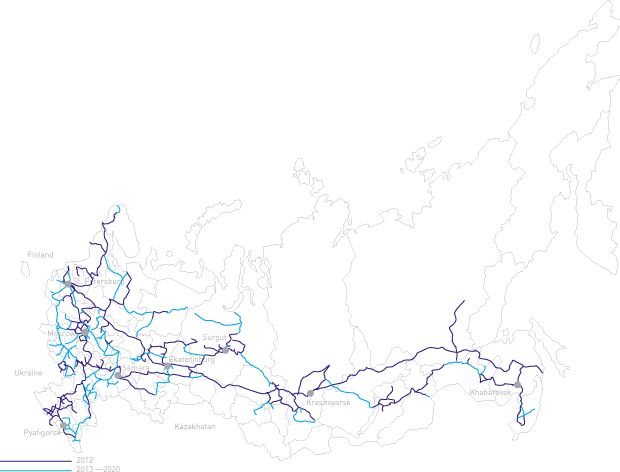
Completion and projected volume of FOSN construction, km

— The Pyatigorsk – Mineralnye Body – Nalchik – Vladikavkaz (670 km);
— The Lipetsk – Voronezh – Belgorod (750 km);
— The Krasnoyarsk – Khabarovsk in the territory in which the MES East operates (750 km).
Satellite Communications Network
To upgrade the reliability and visibility of electric grid facilities, the Company is building a satellite communications network based on VSAT-technology.
In 2013, the Company plans to complete equipping substations with satellite communication installations. While the FOCN-based communication network is formed, the satellite communications network will be used as a backup network. The switch-over of satellite channels to the mode of operating availability will significantly reduce communication costs.
High Frequency Communication Lines
High frequency communication lines are the electric system’s technological communication network that transmits through its channels voice, tele-mechan ics data, and the Automated System for Commercial Metering of Electric Energy, as well as relay protection and emergen cy control commands needed for process control in the power industry (under both normal and emergency conditions). It is a specific type of wire channel, where phase wires and cables of overhead transmission lines are used as a signal-carrying medium. In 2012, as part of the new construction and re-construc tion of electrical grid facilities, the Company upgraded high frequency communication systems and put obsolete equipment out of service due to commissioning the FOCNs.
The Telephone Communications Network
Built on the hub network basis, the power industry’s telephone communications network provides for interactions with the process network of the System Operator and other electricity market participants. The development strategy of the telephone network provides for VoIP technology, along with traditional services.
Equipping UNEG substations with digital switching equipment for telephone communication systems
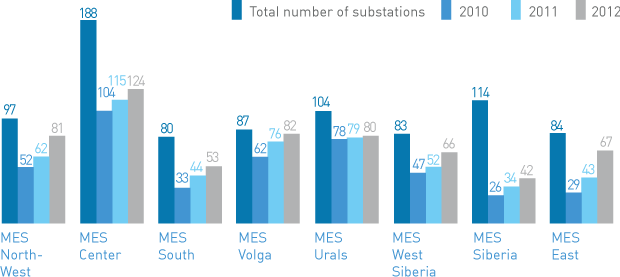
Systems Based on the Global Navigation Satellite System (GLONASS) Technology
Used in corporate branches, the transportation monitoring system based on GLONASS/GPS technology is intended to obtain real time information on the location of transportation vehicles to control the fulfillment of assignments, as well as to monitor mileage and fuel consumption. The implemented transportation monitoring systems are integrated with geographic information systems and an automated transportation operation accounting system. The number of corporate transportation vehicles equipped with GLONASS is growing. During the reporting year, 724 vehicles were equipped with this system, and in 2013, we plan to increase the number of transportation vehicles equipped with GLONASS equipment by more than 100%.
The Company plans to increase the number of transportation vehicles equipped with GLONASS
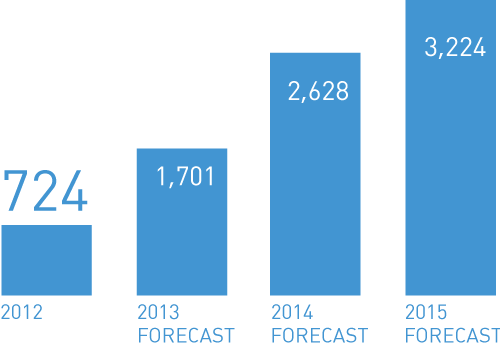
Automated Process Control System
The Automated Process Control System (APCS) is a unified distributed hierarchical system which allows both operational and non-operational functions to be performed by Electric Grid Control Centers, improves UEG mode control efficiency due to the high level of visibility, prevents outages and reduces the time for decision-making and the probability of erroneous actions by operational staff in emergency conditions.
As the UNEG functional control system, the APCS integrates means and sub-systems of existing independently developing automatic and automated control systems (the Automated System of Technological Process Management, the Data Acquisition and Transmission System, the Automated System for Dispatch and Engineering Control, the Relay Protection and Automatics, the Automated Information and Measurement System for Commercial Metering of Electrical Energy), providing a sufficient interface for control systems of the System Operator, the Distribution Electric Grid Companies. As the UNEG operational and development control system, the APCS integrates automation equipment and systems for dispatch & processing and production & technical activities of Federal Grid Company and the MES and PMES services.
14.03.2012
Federal Grid Company
completed installation of the
Automated Information and
Measurement System for the
Commercial Metering of
Electrical Energy (AIMS CMEE)
at the 110 KV Vremennaya
substation in the Sochi Region.
It will be the main source of
power supply for the Media
Center of the 2014 Winter
Olympics (Sochi).
Implementation of the AIMS
CMEE will enable the
Company to receive full
operational parameter data for
the substation network and
transmit it in real time via the
satellite channel to the data
acquisition and processing
center of the MES South and
to Federal Grid Company’s
Executive Office.
As part of the Sozdanie APCS project, the Company is working on implementing:
- The Automated Dispatch and Engineering Control System of Electric Grid Control Centers for (ADECS EGCC) PMES and MES. Within this framework, during the reporting year, we put into operation the Software and Hardware Complex of the Automated Dispatch and Engineering Control System of Grid Control Centers for the Primorsky PMES to provide uninterrupted power supply to the APEC Summit;
- Programs to improve the reliability and visibility of the UNEG (at the facility level). In 2012, Company specialists implemented measures to upgrade the visibility of UNEG facilities at 41 substations.
- The Automated Process Control
System (APCS)is a hardware and
software system intended to collect,
analyze, visualize, store and transfer
process information and to
automatically control the operation of
substation equipment.
Currently, the Company is actively implementing the APCS systems based on the MEK 61859 protocol. Innovative projects involving the establishment of digital substations are under way. The system is equipped with an interface allowing personnel to control SS process operations implemented in line with interactions with the hardware and software complex.
Putting into operation the APOC system
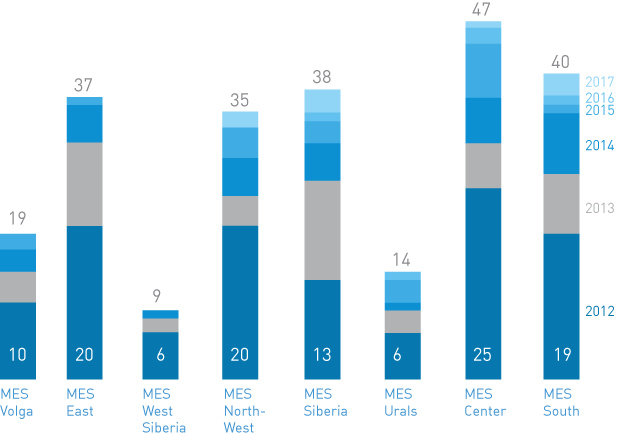
Commissioning data acquisition and transmission systems at the UNEG substations
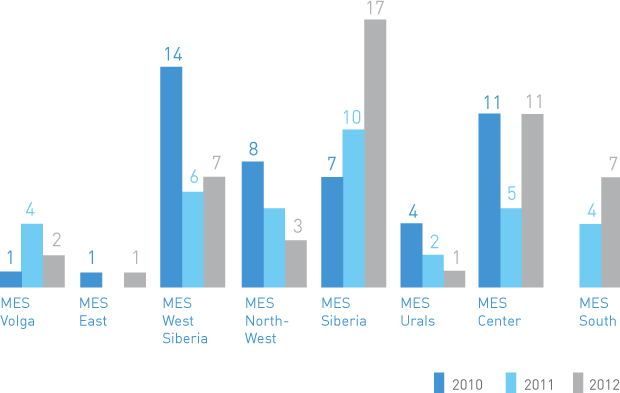
Development of corporate and technological information systems
For the reporting period, we successfully fulfilled the following work and put into operation the following systems:
Within the framework of the Program for the automation of investment activities:
- The Automated project management system based on Oracle Primavera was implemented as a part of Automated system for investment activities management;
- The Automated system “Design and
estimate documentation” was
implemented;
- The project aimed at developing the Automated system “Formation of the nvestment program” was completed n respect to the functions of forming a quarterly financing plan on the approved investment program until 15 December of the year preceding he planned year. The Company also mplemented the function of adjustments in the plan for the current quarter and the next quarters until the end of the year.
Within the framework of the Program for the automation of managing UNEG assets:
- The first stage of the project for creating a budgetary and regulatory base for transmission lines and the electric equipment of substations of the UNEG was implemented;
- The software providing for the
formation and approval of repair and
maintenance plans was developed
and implemented;
- The Automated system for repair and maintenance records was modernized in respect to planning repair and maintenance actions made in-house, and the formation and analysis of the respective records.
Within the framework of the Program for the automation of corporate resources:
- The analytical personnel management system based on SAP HR and SAP BI was implemented;
- The automated system “Record keeping for counter-parties” was implemented.
Within the framework of the Program for the automation of operating management and grid monitoring:
- Replication of the Automated system of recordkeeping and analysis of disturbances for the Company’s branches was completed.
Within the framework of the Program for the automation of asset management:
- The Automated system of contracts management was put into operation;
- The IFRS accounting and reporting system was put into operation.
Within the framework of the Program for IT/Infrastructure development:
- The basic models of the Corporate Information Management System were modernized. The Company switched to an upgraded version of SAP R/3.
Within the framework of the Program for the automation of interactions with customers and the market:
- To provide for the compliance of the Automated system of control and record-keeping for energy resources in substations with WECM’s requirements, the Company received 435 Passports of compliance with Class C for the System and the Passport of compliance of the Automated system for control and record-keeping for energy resources in the UNEG with the same Class C.

 square km
square km